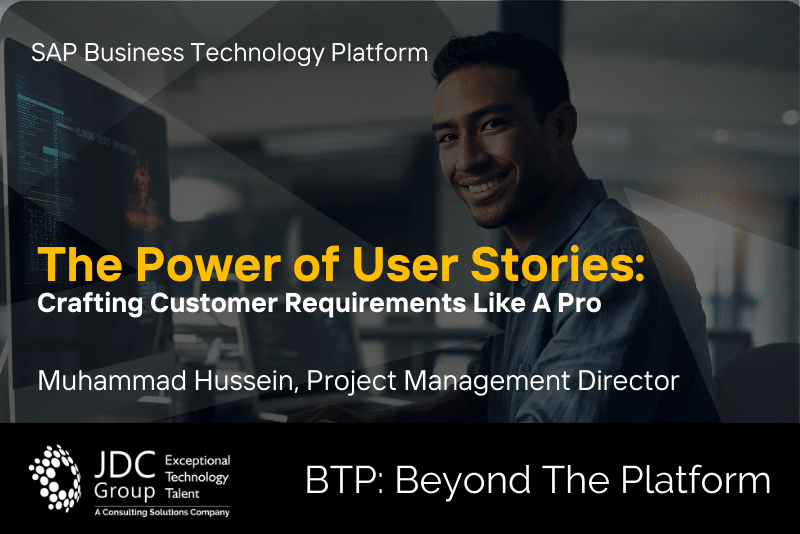By Muhammad Hussein, Project Management Director of BTP Development Services Practice
Whenever I am asked to help with a project that requires special attention, I always start by asking, “What problems are we trying to solve for this customer?”
Oftentimes, in response I’m bombarded with an array of documents, spreadsheets, and slide decks containing complex solution diagrams, long feature lists, and assumptions. But usually, there is no single source of the truth or a clear explanation of what is being built. While some fancy tools may have been used to create product backlogs and user stories, that does not mean they are complete or useful.
User stories certainly play a pivotal role in capturing and conveying the needs and desires of users in the world of product and software development. The best ones are brief, focused insights that offer a glimpse into the user’s perspective by succinctly capturing their needs, goals, and desired outcomes. But how does one write such an effective user story? Following are a few helpful guidelines:
The INVEST Principle
I was unaware of the INVEST principle when I began my career in software development over two decades ago, and I am not sure that many product managers and product owners practice it today. The INVEST principle serves as the gold standard for creating comprehensive user stories. The acronym stands for Independent (self-contained), Negotiable (open for discussions and adjustments), Valuable (users need it), Estimable (how long it takes and how much it costs)., Small (concise and to the point), and Testable (defined criteria to measure completion). INVEST ensures user stories are actionable and meaningful. If you can master this concept, the rest often becomes easy.
Keeping User Stories Simple and Clear
Complex narratives can be misconstrued and potentially lead to misguided outcomes. A straightforward user story often follows this structure: “As a [user role], I want to [action] so that [benefit/value].” Using such a format promotes clarity and highlights the end user’s objective. Remember the V and S from the INVEST principle? The user story must contain a value for the user, and it must be to the point. No ambiguities and assumptions, please.
Including Clear Acceptance Criteria
Acceptance criteria define the parameters of what is expected from a user story. Further, they detail the conditions that determine when a user story is deemed complete. Well-written criteria prevent potential misunderstandings, ensuring all stakeholders are aligned. Clear acceptance criteria are also necessary to successfully test the user story. You would be surprised by how often a team completes all the tasks associated with a user story and then realizes that the acceptance criteria cannot be met, or that the story itself is not testable when all interdependencies are considered.
Collaborating and Communicating
User stories are the product of open collaboration and do not belong to just one team or department. They require input from leaders, process experts, and even end users, which is why it is important to create an environment of collaboration from the beginning. Conduct regular discussions, brainstorming sessions, and feedback loops to enhance the depth and accuracy of user stories. Remember that user stories are negotiable, and a good user story may require all stakeholder groups to negotiate and make concessions. Establishing clear lines of collaboration and communication is key to ensure the user story delivers value to everyone.
Iterating and Refining
As a project progresses, gather new data, feedback, and observations about end users and the solutions you are building. Users’ needs and challenges change over time, so this is to be expected. User stories should evolve to reflect these changes and understanding requirements accordingly. They are not meant to be written once and forgotten. Instead, they are living documents and dynamic in nature, and as such, should be reviewed and updated periodically. This continuous refinement guarantees that the user story always remains relevant and aligned with current user needs.
By following the INVEST principle and these best practices, it’s entirely possible to develop accurate and reflective user stories. When done properly, such stories serve as the foundation for creating successful solutions that truly connect with users and resolve their needs.
JDC Group, a Consulting Solutions company, is one of North America’s fastest-growing SAP Strategic Consulting and Advisory Services providers. JDC Group has earned a reputation among its clients for being a trusted business partner for supporting major SAP transformation programs to drive operational and financial success. JDC Group’s Business Technology Platform (BTP) Development Services practice brings extensive SAP experience and knowledge to address our customers’ business challenges and can help with their cloud transformation journeys. To learn more, visit www.jdc-group.com.
